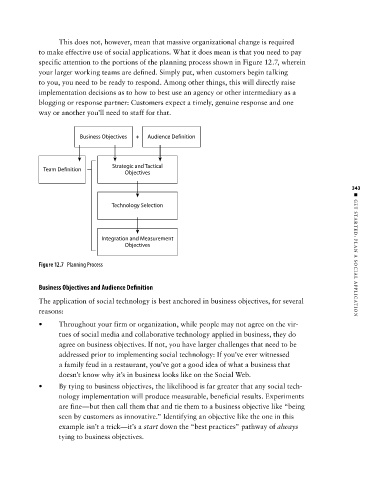Page 365 - Social Media Marketing
P. 365
This does not, however, mean that massive organizational change is required
to make effective use of social applications. What it does mean is that you need to pay
specific attention to the portions of the planning process shown in Figure€12.7, wherein
your larger working teams are defined. Simply put, when customers begin talking
to you, you need to be ready to respond. Among other things, this will directly raise
implementation decisions as to how to best use an agency or other intermediary as a
blogging or response partner: Customers expect a timely, genuine response and one
way or another you’ll need to staff for that.
Business Objectives + Audience De nition
Team De nition Strategic and Tactical
Objectives
343
Technology Selection ■ ╇ G et S tarted : P lan a S ocial A pplication
Integration and Measurement
Objectives
Figure€12.7╇â•P‰ lanning Process
Business Objectives and Audience Definition
The application of social technology is best anchored in business objectives, for several
reasons:
• Throughout your firm or organization, while people may not agree on the vir-
tues of social media and collaborative technology applied in business, they do
agree on business objectives. If not, you have larger challenges that need to be
addressed prior to implementing social technology: If you’ve ever witnessed
a family feud in a restaurant, you’ve got a good idea of what a business that
doesn’t know why it’s in business looks like on the Social Web.
• By tying to business objectives, the likelihood is far greater that any social tech-
nology implementation will produce measurable, beneficial results. Experiments
are fine—but then call them that and tie them to a business objective like “being
seen by customers as innovative.” Identifying an objective like the one in this
example isn’t a trick—it’s a start down the “best practices” pathway of always
tying to business objectives.

